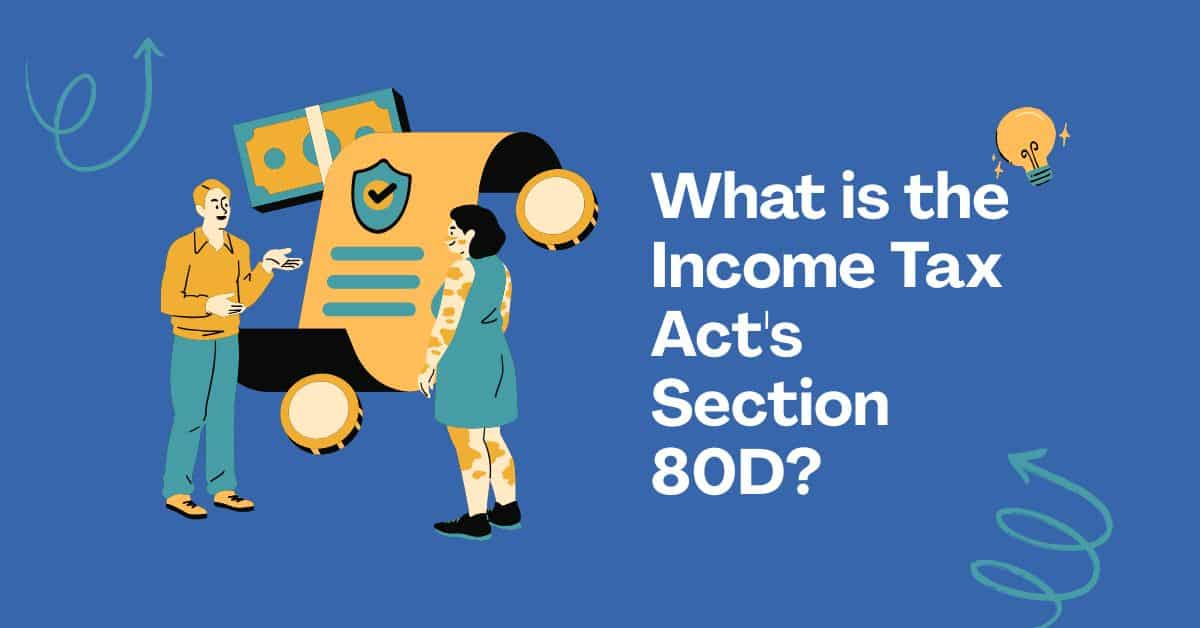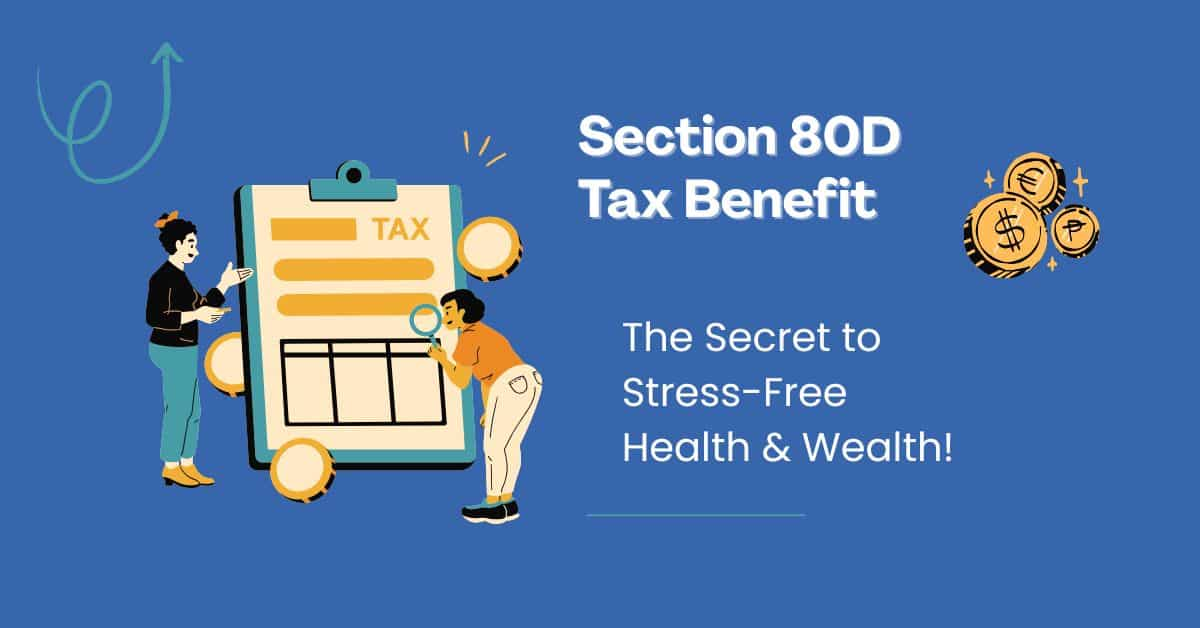Section 80D Tax Benefit: In the fast-paced world of today, where economic challenges and health concerns coexist, finding innovative ways to protect your pocketbook and well-being is revolutionary. The Income Tax Act’s Section 80D is a potent tax deduction that encourages you to purchase health insurance. Understanding Section 80D can result in considerable tax savings and guarantee medical care for you and your loved ones, regardless of whether you are an Indian business owner, freelancer, or salaried professional. Imagine creating a safety net against growing healthcare expenditures while reducing your taxable income by up to ₹1,00,000 each year. The complexities of Section 80D tax benefits, eligibility, 2025–2026 limits, the claiming process, and practical advice to optimise your deductions are all covered in detail in this extensive guide. By the conclusion, you’ll understand why this clause is the key to riches and stress-free health in 2025.
Making health insurance a top priority is not only smart, but also necessary as we move through the financial year 2025–2026 (assessment year 2026–27), when healthcare inflation is estimated to be between 15% and 20%. Let’s examine how Section 80D can change the way you arrange your taxes.
What is the Income Tax Act’s Section 80D?
Under Chapter VI-A of the Income Tax Act of 1961, Section 80D is a provision intended to incentivise individuals and Hindu Undivided Families (HUFs) to make investments in preventative care and health insurance. It was created to encourage financial stability in the event of medical emergency and permits deductions for medical insurance premiums, government health program contributions, such as the Central Government Health Scheme (CGHS), and even costs associated with preventive medical examinations.

Section 80D is a focused instrument for comprehensive financial planning because it only covers health-related expenses, unlike other deductions. It is accessible under the previous tax regime; if your deductions beyond the new regime’s standard benefits, you may choose to use it.
The key highlights include:
- Deductions for parents, dependent children, spouse, and self.
- Coverage with higher limitations for senior citizens.
- Incorporating health prevention strategies to promote proactive well-being.
By lowering the cost of insurance through tax breaks, Section 80D essentially supports the government’s goal of universal health coverage, as seen by programs like Ayushman Bharat.
Who Can Take Advantage of the Section 80D Deduction?
Although qualifying under Section 80D is simple, it is essential to get it right for smooth claims. According to the most recent regulations modified by the Finance Act of 2025, the deduction is available to:
- Individuals: Indians who are residents or not, include self-employed people, freelancers, and salaried workers.
- HUFs, or Hindu Undivided Families: for premiums paid by any member of the family.
You are eligible to make a claim for:
- You, your spouse, and any dependent children (children do not need to be dependents, but they must be).
- Your parents, including your biological and adopted parents, whether you are reliant on them or not.
Important Notes:
- People who are 60 years of age or older throughout the fiscal year are considered senior citizens. The deduction cap for seniors, regardless of their super senior status, is ₹50,000. Super senior people are defined as those who are 80 years of age or older.
- If non-resident Indians (NRIs) pay premiums for family insurance policies in India and have taxable income in India, they are also eligible to make a claim.
- The policy must be issued by an insurer approved by the General Insurance Corporation or via a program such as CGHS.
Exclusions: Unless you pay an additional personal premium, deductions are not possible for group health insurance premiums paid by employers. Additionally, except for preventive check-ups, cash payments are not eligible.
FY 2025–2026 Section 80D Deduction Limits
For FY 2025–2026, the Section 80D deduction limits are unaltered, providing stability in the face of economic volatility. For clarity, here is a thorough breakdown presented in a table:
| Category | Age Group | Maximum Deduction (₹) |
| Self, Spouse, Dependent Children | Below 60 years | 25,000 |
| Self, Spouse, Dependent Children | 60 years and above | 50,000 |
| Parents | Below 60 years | 25,000 |
| Parents | 60 years and above | 50,000 |
| Preventive Health Check-ups | All | 5,000 (within the above limits) |
| Medical Expenditure (if no insurance) | Senior Citizens (60+) | 50,000 |
Maximum Allowable Deduction: The total can exceed ₹1,00,000 (₹50,000 + ₹50,000) if you, your spouse, children, and your parents are all elderly.
Regarding HUFs: Individuals are subject to the same limitations, which are ₹25,000 basic and ₹50,000 for senior members.
Pro Tip: Since multi-year premiums can be claimed proportionately over time, always double-check the policy specifics.
A Comprehensive Guide on How to Claim Section 80D Deduction
Being organised makes it easy to claim Section 80D. For FY 2025–2026, do the following actions:
- Get a Qualifying Policy: Choose government programs or health insurance from IRDAI-approved companies like HDFC Ergo and ICICI Lombard.
- Pay: For premiums, use non-cash methods such as credit cards, online transfers, and checks. Preserve policy documentation and receipts.
- Collect Evidence: Gather bills for medical expenses or preventative check-ups, as well as proof of premium payment (provided by the insurer).
- ITR file: In your Income Tax Return (ITR-1 or ITR-2 for most), under ‘Deductions under Chapter VI-A’, insert details in the Section 80D field. Utilise incometax.gov.in e-filing portal.
- Check and Send in: To avoid notices, double-check your calculations. Provide evidence if you are audited.
Common Mistakes to Avoid:
- Claiming premiums paid by the employer.
- Surpassing boundaries without appropriate bifurcation.
- Neglecting to incorporate preventative examinations.
Claiming is now quicker thanks to digital tools like the Income Tax Department’s portal; for AY 2026–2027, try to file by July 31, 2026.
Examples of Section 80D in Action in the Real World
Let’s use the following possibilities for FY 2025–2026 to demonstrate:
Example 1: Young Family
- Mr. Amit, 35, pays ₹18,000 for his wife, child, and himself (all under 60).
- Pays parents (both under 60) ₹22,000.
- For preventive check-ups, add ₹4,000.
- Deduction total: ₹44,000 (₹22,000 for parents and ₹22,000 for self/family, including check-up).
Example 2: Scenario of Senior Citizens
- Mrs. Priya (62) pays her husband (65) and herself ₹45,000.
- Covers medical costs and ₹40,000 for parents (ages 85 and 82, without insurance).
- Total deduction: ₹90,000 (parents’ ₹40,000 + self’s ₹50,000 maximum).
These examples demonstrate how Section 80D may transform health investments into wealth builders by lowering your tax obligation by 5–30%, depending on your slab.
Why Section 80D Is Essential for Wealth and Stress-Free Health
Section 80D encourages a proactive attitude to health in addition to tax savings:
- Benefits to health: Promotes routine examinations, which lowers long-term medical expenses.
- Building Wealth: Tax savings can be reinvested in stocks or mutual funds, which will grow in value over time.
- Inflation Hedge: Insurance safeguards your savings as medical expenses rise.
- Family Security: Provides financial stability in times of crisis by protecting dependents.
Leveraging 80D is in line with financial freedom objectives in 2025, when post-pandemic knowledge is high; consider it as insurance for your future self.
Frequently Asked Questions (FAQs)
For FY 2025–2026, what is the maximum deduction allowed under Section 80D?
If you and your parents are elderly, the maximum is ₹1,00,000, which is ₹50,000 for you and your family and ₹50,000 for your parents.
Can I deduct cash payments under Section 80D?
No, with the exception of ₹5,000 for preventative medical examinations. Non-cash premiums are required.
Does the new tax structure allow for Section 80D?
No, just under the previous government. Considering all deductions, make an informed choice.
What if my parents don’t rely on me? Am I still able to make a claim?
Yes, Section 80D does not require parents to be dependent.
Can NRIs receive benefits under Section 80D?
Yes, if they pay the required premiums and have taxable income in India.
Are riders with serious illnesses covered by Section 80D?
Yes, provided it is covered by the health insurance policy.
What distinguishes 80DDB from Section 80D?
80DDB is for the treatment of specific disorders, with a maximum limit of ₹1,00,000 for seniors; 80D is for insurance premiums.
Does Budget 2025 bring any modifications to Section 80D?
No significant alterations; the Finance Act of 2025’s limitations still apply.
Conclusion
Section 80D is a strategic tool for enhancing financial and health resilience, not just a tax gain. With an emphasis on economic recovery in FY 2025–2026, making the most of this deduction can result in significant savings and improved quality of life. Review your insurance requirements, speak with a tax professional, and incorporate them into your yearly planning as a first step. Keep in mind that making wise decisions now will lead to a stress-free tomorrow.
Best Tax Saving Schemes in India with High Returns – Secure Your Future Today!
10 Practical Tax Planning Strategies for Small Business Owners in India
PPF vs ELSS for Tax Saving in India – Which One Should You Choose?

I’m Rashid Ali, a personal finance blogger and content creator at SavingSecret.in, helping young adults in India master saving, investing, and tax planning. I simplify money topics like budgeting, IPO updates, and stock market tips to make finance easy and actionable. Follow me for smart money moves that actually work!
